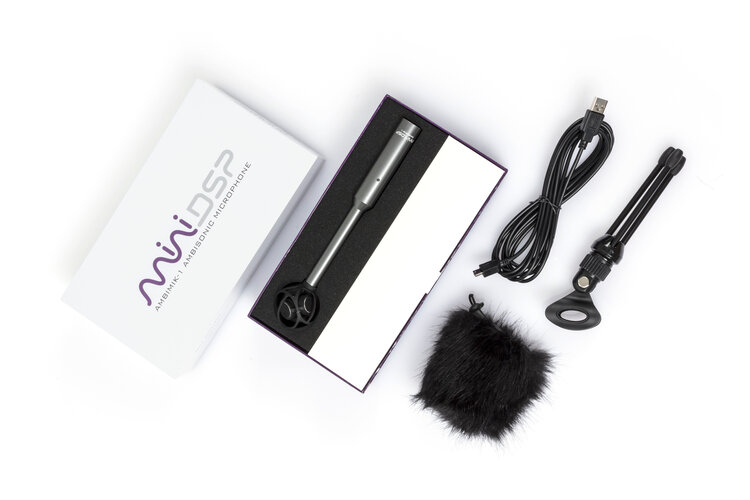
In Augmented Reality and Virtual Reality News
August 14, 2020 – Spatial audio company Dirac, and miniDSP, a Hong Kong-based developer of digital signal processing (DSP) platforms, have announced the launch of the ambiMIK-1, a consumer-driven, Ambisonic USB microphone for content creators & music makers. The new ambiMIK-1 with 3D audio processing from Dirac will allow augmented and virtual reality (AR/VR) developers, musicians, podcasters, videographers, and vloggers to record immersive, spatial audio that can be played back over any stereo headphones.
The ambiMIK-1 plugs directly into a standard USB port to capture lifelike, 360-degree sound for a variety of applications, from recording music to producing augmented/virtual reality content. No sound card, external preamp, or XLR cables are required. The bundled Dirac 3D audio software — custom designed for the ambiMIK-1 microphone — allows producers to turn captured 3D sound into binaural audio for immersive listening through standard headphones or VR headsets.
“With the ambiMIK-1, we have democratized 3D audio recording, playback, and content creation,” stated Tony Rouget, Founder and CEO of miniDSP. “The ambiMIK-1’s unique combination of ultra-portability, high sample rate, and low price mean virtually anyone can record rich, high-quality, spatial audio, whether they’re capturing the immersion of a live music performance or the 360-degree soundscape of a virtual reality experience.”
Ambisonic microphones include multiple capsules for capturing sound from different directions. The ambiMIK-1 comes with four 14-millimeter, low-noise cardioid capsules, along with built-in analog-to-digital converters, an embedded preamplifier, and USB processor in a lightweight aluminum body. It’s capable of recording 32-bit, multichannel audio at sample rates up to 192 kHz, according to the company.
To create the plug-and-play ambiMIK-1 Ambisonic microphone, miniDSP teamed up with Dirac for the custom virtual studio technology/audio unit (VST/AU) software plug-in needed for editing and processing in Windows and Mac-based digital audio workstations. For each of the ambiMIK-1’s four capsules, Dirac measured microphone response in 300 directions (1,200 total measurements) to develop the custom filters required for turning raw microphone recordings into quality 3D audio. The amibMIK-1 with Dirac can output audio in Ambisonic B-format, popular for post-processing into virtual reality applications, or binaural format, for listening to spatial sound with headphones.
“The custom solution we developed for miniDSP draws from our extensive research into 3D audio psychoacoustics and multichannel digital filter optimization,” said Mathias Johansson, Dirac co-founder & CEO. “It leverages our proprietary, dynamic head-related transfer function (HRTF) database to create highly accurate, localized sound for any 3D audio application. With the Dirac-enabled ambiMIK-1 microphone, content creators of all types can record dynamic, spatial sound that can then be experienced by fans over any headphones. It’s a technology once reserved for the professionals, now delivered to the masses.”
With the Dirac-enabled ambiMIK-1 and its native support for binaural output, users can create recordings of performances that can then be experienced through any headphones. For example, podcasters can record interviews with groups and, when played back, their voices will sound like they’re coming from different positions in space for a more realistic-sounding conversation. Amateur videographers and vloggers can add a more professional, cinematic 3D sound experience to their films and shorts. And because the Dirac-based ambiMIK-1 also supports Ambisonic (B-format), engineers can use the microphone to capture audio that they can then adapt to VR, gaming, and 360-degree video content.
The ambiMIK-1 microphone is available now for UDS $349 and comes with a license for the custom Dirac VST/AU plug-in, a shielded USB cable, a mini tripod, and a wind-screen.
Image credit: Dirac / miniDSP
About the author
Sam is the Founder and Managing Editor of Auganix. With a background in research and report writing, he has been covering XR industry news for the past seven years.




